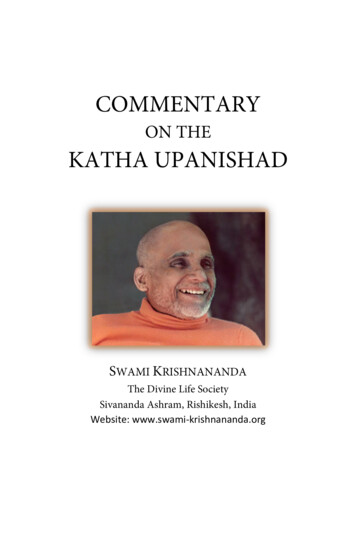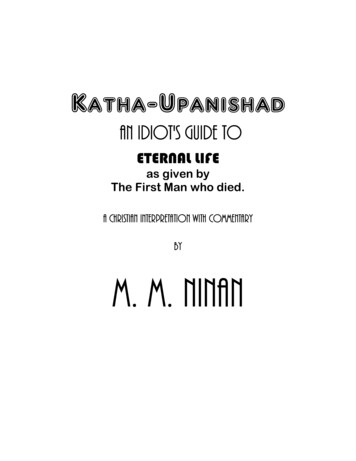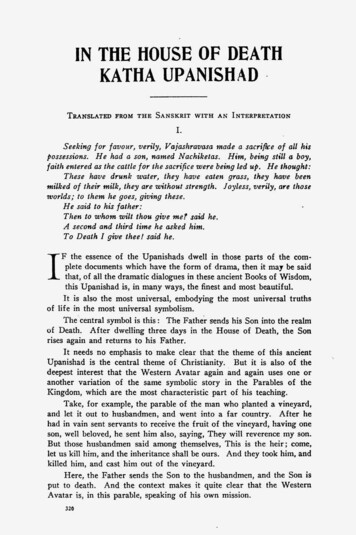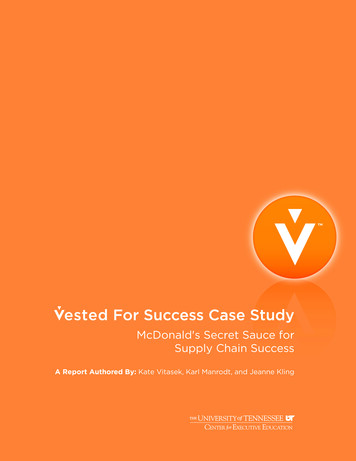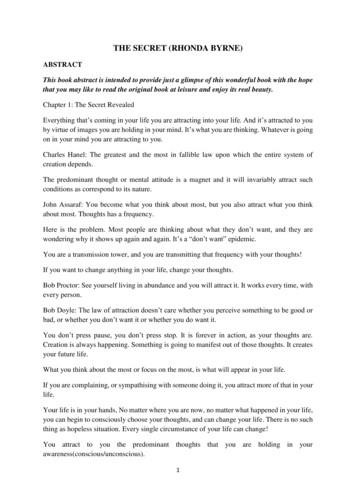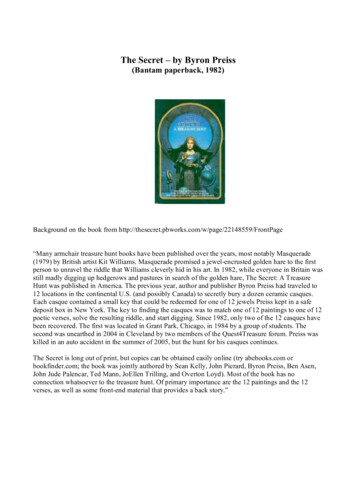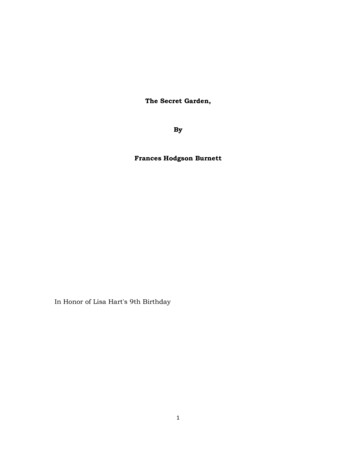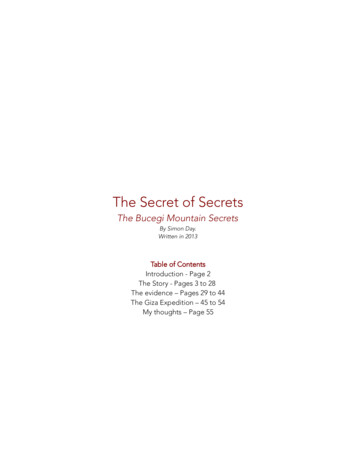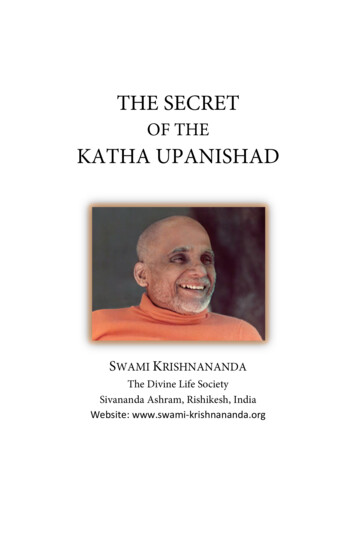
Transcription
THE SECRETOF THEKATHA UPANISHADSWAMI KRISHNANANDAThe Divine Life SocietySivananda Ashram, Rishikesh, IndiaWebsite: www.swami-krishnananda.org
ABOUT THIS EDITIONThough this eBook edition is designed primarily fordigital readers and computers, it works well for print too.Page size dimensions are 5.5" x 8.5", or half a regular sizesheet, and can be printed for personal, non-commercialuse: two pages to one side of a sheet by adjusting yourprinter settings.2
CONTENTSPreface . 4Discourse No. 1 . 6Discourse No. 2 . 22Discourse No. 3 . 50Discourse No. 4 . 74Discourse No. 5 . 91Discourse No. 6 . 107Discourse No. 7 . 120
PREFACEThe contents of the present book form the theme of thediscourses which the Swamiji delivered for seven days duringthe Sadhana Week held at the Headquarters of the Divine LifeSociety, in the year 1973, before an audience of seekers ofvaried endowments and differing capacities on the path ofspiritual practice. Hence, the lectures bear, naturally,an informal and personal touch of the teaching style, andthis also explains the conversational accent maintainedthroughout, rather than a stricter form of expression usuallyassociated with a deliberately written text.The First Discourse starts with the present state ofhuman perception and understanding in its empirical set-up;and explains the exoteric sacrifice (yajna) of Sage Vajasravasato gain celestial ends; the query of Nachiketas; the meeting ofNachiketas and Yama, the Lord of Death; the three boonsNachiketas requested for; the temptations on the way; thepersistence of the seeking soul; the distinction between thepleasant and the good in world-experience.The Second Discourse explains the meaning of thepleasant and the ultimate good; the error involved in thedesire for pleasant sensations of the body and the ego; thepoint concerning life here and hereafter; the pattern of worldexperience as analysed; the spiritual import of the Upanishadteaching; the three stages of the mystic ascent of the souloutlined in the three boons offered to Nachiketas.The Third Discourse points out the disciplines that arenecessary for the pursuit of the Inner Life; the need for aspiritual guide; the nature of the higher knowledge; the seven4
stages of meditation on Reality; the characteristics of the finalgoal of life.The Fourth Discourse delineates the super-logical natureof Reality and its knowledge; the methods of yoga describedthrough the analogy of the chariot of the human individualityin its relation to Reality, as the most practical part of the wholeexercise of spiritual endeavour; the difficulties on the path; thesubtleties of the Inner Way of the Spirit.The Fifth Discourse investigates the intellectual processesin sensation, perception and cognition; the techniques ofabstraction, concentration and meditation; the nature andexperience of the merger of the individual in the Universal.The Sixth Discourse expounds the glorious march of thesoul along the path to the Absolute; the higher yoga of theConsciousness and its supernal attainments.The Seventh Discourse clinches the mystery of life anddeath; and the methods of communion with the SupremeBeing.We are confident the students of philosophy and yoga willfind, on a close study, that one rarely does come across apresentation to be placed in one’s hands in which the fire ofthe soul burns so brightly through its pages.—THE DIVINE LIFE SOCIETYShivanandanagar,27th January, 19775
DISCOURSE NO. 1ōm saha nāvavatu; saha nau bhunaktu;saha viryam karavāvahai;tejasvi nāvadhitamastu;mā vidvishāvahai;ōm Sāntih; Sāntih; SāntihOm! May He protect us both, (the teacher and thetaught). May He cause us both to enjoy protection. May weboth exert to find out the true meaning of the scriptures. Maywe never quarrel with each other. Let there be threefoldPeace. Om. Peace! Peace! Peace!It is the wish of several seekers who have come toparticipate in the Sadhana Week this year that during thisholy occasion a concise presentation be made of theprinciples expounded in the great Vedic scripture, knownas the Katha Upanishad. The purpose of so many sadhakascoming from long distances to this sacred abode at the footof the Himalayas is obvious, viz. to gain a knowledge of thesecret of life and gain also an access into the mysteries inwhich our life seems to be involved. The aim and mission ofyour visit to this sacred abode is naturally, as it ought to be,the revelation or the unfoldment of the entanglement ofyour personality, the involvements of your life, and toreturn with a newer type of enlightenment about that whichyou are, and that which involves you or in which you areinvolved.Our life itself is the subject of study in the KathaUpanishad. Our life is a beautiful pattern of variousthreadwork woven dexterously by an expert Maker of allthings, such that one cannot easily or intelligibly
comprehend how it is made or why it is made. We often, ashuman beings, take life for granted, as if it is an open bookbefore us. We regard our life as a clear presentation likedaylight and go headlong along the business of our dailyactivities under the impression that things are perfectlyperspicuous and we have simply to act on the thought thatoccurs to our mind. This is an unfortunate assumption onthe part of the human being. The cloth of life is spreadbefore us, but it is not a flat surface as we imagine it to be.In ancient times, it is said, most people imagined theworld or the earth to be a flat surface; the sun rose and thesun set, illumining a perfectly flat surface of the earth, notknowing that it was round like a ball or something like that.It was also thought that the sun revolved round the earth;the sun was smaller than the size of the earth, not knowingthat the revolution of the planetary system is a highlycomplicated involvement of powers and forces not easilyreducible either merely to the sun or the planets as theearth. Today astronomy, the science of the existence andthe operation of the planets and the stellar system, is knownto be a highly complicated structure of forces rather than ofthings. Likewise we, with a crass perception of visibleobjects, mistaking objects seen with our senses for whatthey appear to be, rush like fools where even angels fear totread. The consequence is that we are caught in the grip ofunknown powers and forces. As monkeys are caught withthe help of rope-nets spread to divert them into a mistakenidea of food being spread for them for their maintenance,likewise, the Maker of things seems to have spread outbefore us a pattern we call the world which we mistake for a7
heaven of enjoyment for our senses; but when we rush intoit we are caught, and then it would be too late for us torepent.Everyone has been caught in this network of thingscalled the world, right from creation up to the present day,and we have no reason to believe that the future generationwill not be so caught. The pattern of life is not merely alocation of objects for our enjoyment, for our likes anddislikes. The pattern of existence is a tremendously wellthought-out involvement, externally as well as internally.The more we probe into the mystery and the structure ofthis involvement of the world, the more we begin to admirethe wisdom of the Maker of things. It is not a simplestructure. It is not a small ball of earth we call the planet onwhich we merely live like ants crawling on the surface of aball. The world, our life, is more subtle and more involvedin various ways than our intelligence can permit us tounderstand.This mystery is the subject of the Katha Upanishad,which is generally defined as the mystery of death and themystery of life. Well! Both mean one and the same thing ifwe understand them carefully. Life and death are identical.They are two aspects of one and the same event that takesplace. This mystery of life, or the mystery of death as youwould like to call it, is the secret of the Katha Upanishad;and side by side it is also a revelation of the mystery of thewhole of existence, the mystery of you, the mystery of meand the mystery of everyone else, the mystery of yourdeeds, the mystery of the reactions of your actions, the8
mystery of the consequences of what you do and suffer andenjoy, the mystery of God Himself.We shall, during these few days before us, try to have aquintessential comprehension of this very interestingUpanishad—‘Upanishad’ which means the secretknowledge or the wisdom of life—and try to be blessed inour souls that our speaking as well as listening becomes acontemplation of a particular form, a meditation, veritably,by which I pray and I wish that our souls may be lifted upinto a higher knowledge and experience.The Katha Upanishad is one of the esoteric appendicesto a section of the Vedas known as the Brahmanas. Aparticular Veda has a particular Brahmana and it has also a concluding esoteric exposition known as theUpanishad. The Katha Upanishad is such an esoteric,mystical, spiritual exposition appended to a Brahmana ofthe Krishna- Yajur-Veda. This Upanishad has within itimplanted the wisdom of the entire life of man woven intoa story of a great seeker of Reality we know as Nachiketas.This is the story of a great aspirant called Nachiketas; howthis young lad aspired for the highest Reality of life and gotan access into it through the working of mysterious forces.The story that is the background of this exposition ofthe Upanishad is something like this—to give you inoutline. There was a sage called Vajasravasa, known also asGautama. He performed a yajna or a sacrifice calledVishvajit, a yajna or a sacrifice by which he aspired to enterthe heaven of the gods. This sacrifice was of a very peculiarnature which demanded of the performer that he gave incharity everything that he possessed, dear and near. This9
Vishvajit sacrifice known as the sarvavedasa yajna wasperformed by Gautama or Vajasravasa, the sage. In thisyajna, through which performance he aspired to enjoy thepleasures of the heaven of the gods, he gave in charity asphilanthropy everything that he possessed. All hisbelongings were given in charity—everything, whatever bethe value of that possession—because that was therequisition of the yajna. Everything was given, and given,and given, nothing was left. Every day he began to give incharity all his possessions. This great sage known asVajasravasa had also a son, perhaps the only son, known asNachiketas. This unlettered boy, perhaps, untutored,simple, unsophisticated, observed this wonderful ritualisticperformance of the Vishvajit sacrifice by his father, went onseeing everything being given—‘all things are going’. All thewealth of the sage was being given. Those days cattle wereregarded as a great wealth. The cattle wealth was held to bereal wealth. All the multitude of the cattle belonging to thesage were given in charity, but unfortunate it was to thesensitive mind of the poor lad Nachiketas, he began toobserve that these cattle were famished. They were onlyskeletons. Such cows were being given in charity—the cowswhich had drunk their water for the last time, which hadeaten their grass for the last time, which were not going tocalve again, which were without any strength in the bodyand were tottering with their poor legs. “Oh! Such charity isbeing given by my father!” The boy had no guts to speakbut something urged him to speak forth his feelings. Thesensitive lad spoke out his inner heart and called out to hisfather, “Father, you give everything that belongs to you. I10
am your son. Perhaps I too belong to you. To whom do youpropose to give me in charity? Because in this sacrifice youhave to offer everything that belongs to you, and inasmuchas a son also seems to be a property of the father to someextent, evidently you think of giving me also. To whom doyou want to give me?” The father had no idea of giving theson in charity to anyone. It was the last thing that he couldimagine. The father paid a deaf ear to the words of the son.He said nothing. The second time the son asked the samequestion, “To whom do you want to give me, father?” Hedid not say anything. He was wroth. “Oh, this boy is buttingin and impertinently putting me a question!” When a thirdtime the boy asked the same question, the father responded,“To hell you go.” This is what we generally say when we areirate. And he said, “To death I give you.” He was angry.“Oh, I see! You give me to death.” The boy went onthinking, “What has death to do with me, death presidedover by Yama? I am being sent to him. What has Yama, theLord of Death, to do with me? I do not understand.”This imprecation of the father upon the son, the cursethat he threw upon him, evidently drew the soul out of thebody of the boy. He died, apparently, if we read between thelines of the Upanishad. The boy went to the abode of Yamain search of that for which the father seems to have senthim. Yama is not there to be seen. The guest is standingoutside the gates of the palace of the Lord of Death, Yama,but the master of the house is absent. Somewhere he hasgone. No one knows what has happened to him or where hehas gone. One day passes, one night passes, the second dayand night passes, the third day and night passes. The boy is11
standing there without water, without food. Nothing can beworse for a man than for a guest to stand starving at hisgate. It is said that if a guest starves at the ga
as the Katha Upanishad. The purpose of so many . sadhakas. coming from long distances to this sacred abode at the foot of the Himalayas is obvious, viz. to gain a knowledge of the secret of life and gain also an access into the mysteries in which our life seems to be involved. The aim and mission of your visit to this sacred abode is naturally, as it ought to be, the revelation or the .
